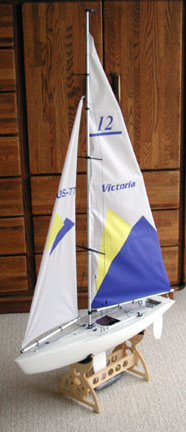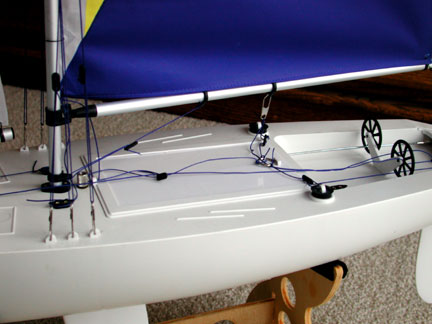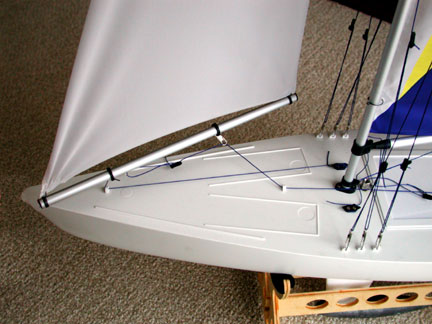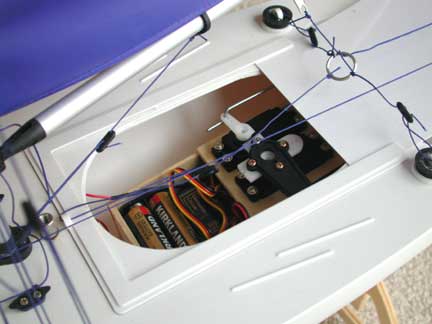Description: Original Victoria by Thunder Tiger

This boat was built from a kit, the Victoria by Thunder Tiger. The kit is easy to assemble and is fun to sail. The instructions consist of 15 steps with words and pictures. Assembly takes approximately eight hours to complete. Assembly time is dependent on the level of finish desired.
These are pictures of a boat assembled according to the instructions (by my father-in-law). It shows the standard hull, decorated sails and rigging. It is missing some hull decorations but otherwise is built according to the instructions.
Length: 779 mm (30.7 inches)
Mast Height: 1086mm (42.75 inches)
Sail Area: 28.6 square dm (433 square inches)
Weight: 2.1 kg (4.6 lbs)
The mast, rudder and keel can be removed for transportation.
Spare parts are readily available.
Rigging
The original rigging is show below. The sail control line comes up from the servo under the deck and goes through the main sail boom ring. Adjustements on either side allow the ring to be centered and to have the right amount of height. The length of the main sail line is adjusted at a cleat in the cockpit.

The jib uses the same servo and the length is adjusted at the cleat on the port site of the mast. Sail tension, gooseneck fitting, and jib tension are all adjusted with small cleats or "line adjusters".

The batteries, receiver, and servos are all mounted in a single box. The servo on the top, with the metal rod bent like the letter "Z", is for the rudder. The lower servo controls tension on both the jib and main sails. It has an arm attached, extending out of view towards the port side.

Problems:
- The lines are difficult to adjust. My fingers are not that small and the lines come loose on the cleats. Even rigging knots loosen when the wind starts blowing.
- The rigging is overly complex. Perhaps I do not understand how to get the most speed and maneuverability from this boat, but simplifiying the rigging made it more fun for me.
- The mast and booms are heavy, adding weight up top, encouraging the boat heel and spill wind.
- The battery and servo box cannot be moved to adjust the center of weight.
- Water enters the hull in any number of places. It leaks! While normal, I try to discourage it as much as possible.
- The sails are not cut properly and do not retain their shape, making them inefficient.
- I wanted mine to be faster than my father's-in-law...
